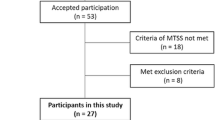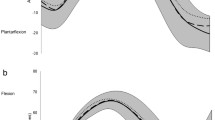Abstract
In spite of some significant progress in the understanding of the biomechanics of the ankle joint complex, especially the coupling mechanism between foot and leg, various mechanisms causing overuse injuries in the lower extremities are still poorly understood. Some increased pronation of the foot is often physiological, but excessive pronation is potentially harmful. Compensatory overpronation may occur for anatomical reasons. However, not only the amount of foot eversion, but also the way this eversion is transferred into tibial rotation may be crucial to the overloading stress on the knee. In other words, the individual transfer mechanism of foot eversion into internal tibial rotation may be of some predictable value for lower extremity overloading and related injuries.
Further research is necessary to improve the functional understanding of anatomical and biomechanical abnormalities and their pathological value in predicting overuse injuries.
Similar content being viewed by others
References
MacIntyre JG, Taunton JE, Clement DB, et al. Running injuries: a clinical study of 4173 cases. Clin J Sports Med 1991; 1: 81–7
Orava S. Exertion injuries due to sports and physical exercise: a clinical and statistical study of nontraumatic overuse injuries of the musculoskeletal system of athletes and keep-fit athletes [thesis]. Oulu: University of Oulu, 1980
Renström P, Johnson RJ. Overuse injuries in sports: a review. Sports Med 1985; 2: 316–33
Clanton TO. Etiology of injury to the foot and ankle. In. Drez D, DeLee JC, editors. Orthopaedic sports medicine. Philadelphia (PA): W.B. Saunders, 1992: 29–52
Hintermann B, Nigg BM. Epidemiology of foot and ankle disorders. In. Nordin M, Andersson GBJ, Pope MH, editors. Musculoskeletal disorders in the workplace: principles and practice. St Louis (MO): Mosby, 1996: 536–49
Lysholm J, Wilander J. Injuries in running. Am J Sports Med 1987; 15: 168–71
Slocum DB, James SL. Biomechanics of running. JAMA 1968; 205: 720–8
Renstroem PA. Prevention of sports injuries. In. Kannus P, Krauss RH, editors. Sports medicine. Philadelphia (PA): W.B. Saunders, 1991: 53–72
Stanish WD. Overuse injuries in athletes: a prospective study. Med Sci Sports Exerc 1989; 16 (1): 1–7
Walther SD, Hart LE, McIntosh JM. The Ontario cohort study of running-related injuries. Arch Intern Med 1989; 149: 2561–4
Hamilton WG. Foot and ankle injuries in dancers. Clin Sports Med 1988; 7: 143–73
Howse J. Disorders of the great toe in dancers. Clin Sports Med 1983; 2: 499–505
Marshall P. The rehabilitation of overuse foot injuries in athletes and dancers. Clin Sports Med 1988; 7: 64–70
McNeal AP, Watkins A, Clarkson PM, et al. Lower extremity alignment and injury in young, professional, college and professional ballet dancers: II. Dancer-reported injuries. Med Probl Perform 1990; 5: 83–8
Solomon RL, Trepman E, Nicheli LJ. Foot morphology and injury patterns in ballet and modern dancers. Kinesiol Med Dancers 1989; 12: 20–40
Clement DB, Taunton JE, Smart GW, et al. A survey of overuse running injuries. Phys Sports Med 1981; 9: 47–58
Hintermann B, Holzach PJ. Die Bursitis subachillea - eine biomechanische Analyse und klinische Studie. Z Orthop 1992; 130: 114–9
James B, Bates B, Osterning L. Injuries in running. Am J Sports Med 1978; 6: 40–50
Smart GW, Taunton JE, Clement DB. Achilles tendon disorders in runners: a review. Med Sci Sports Exerc 1980; 12 (4): 231–43
Clanton TO. Sport shoes, insoles and orthoses. In. Drez D, DeLee JC, editors. Orthopaedic sports medicine. Philadelphia (PA): W.B. Saunders, 1992: 322–46
Hintermann B. Einlagen und Schuhkorrekturen bei Leistungssportlern - eine 3-Jahresstudie bei jugendlichen Skilangläufern. Schweiz Rundsch Med Prax 1992; 81: 389–94
McKenzie DC, Clement DB, Taunton JE. Running shoes, orthotics and injuries. Sports Med 1985; 2: 324–7
Levens AS, Berkeley CE, Inman VT, et al. Transverse rotation of the segments of the lower extremity in locomotion. J Bone Joint Surg 1948; 30A: 859–72
Mann RA. Biomechanics of running. In. Frankel VH, editor. Foot problems in adults: I. Biomechanics of the foot. Vol 31. St Louis (MO): Mosby, 1982: 167–80
Nigg BM, Hintermann B. Biomechanics of the ankle joint complex and the shoe. In. Nordin M, Andersson GBJ, Pope MH, editors. Muskuloskeletal disorders in the workplace: principles and practice. St Louis (MO): Mosby, 1996: 558–69
Sutherland DN, Hagy JL. Measurement of gait movements from motion picture films. J Bone Joint Surg Am 1972; 54: 787–99
Mann RA, Baxter DF, Lutter L. Running symposium. Foot Ankle 1981; 1: 190–224
Hintermann B, Nigg BM, Sommer C. Foot movement and tendon excursion: an in vitro study. Foot Ankle 1994; 15 (7): 386–95
Allinger TL, Engsberg JR. A method to determine the range of motion of the ankle joint complex, in vivo. J Biomech 1993; 26: 69–76
Hicks JH. The mechanics of the foot: I. The joints. J Anat 1953; 87: 345–57
Wright DG, Desai SM, Henderson WH. Action of the subtalar and ankle-joint complex during the stance phase of walking. J Bone Joint Surg 1964; 46A: 361–82
Inman VT. The ankle joint. In. Stiel JB, editor. The joints of the ankle. 2nd ed. Baltimore (MD): Wiliams & Wilkins, 1991: 31–8
Lundberg A. Kinematics of the ankle and foot: in vitro stereophotogrammetry. Acta Orthop Scand 1989; 60 Suppl. 233: 1–24
Manter JT. Movements of the subtalar and transverse tarsal joints. Anat Rec 1941; 80: 397–400
Isman RE, Inman VT. Anthropometric studies of the human foot and ankle [technical report 58]. San Francisco: Biomechanics Laboratory, University of California, 1968: 1–12
Langelaan van EJ. A kinematic analysis of the tarsal joints. Acta Orthop Scand 1983; 54 Suppl. 204: 15–49
Siegler S, Chen J, Schneck CD. The three dimensional kinematics and flexibility characteristics of the human ankle and subtalar joint. J Biomech Eng 1988; 110: 364–73
Engsberg JR. A biomechanical analysis of the talocalcaneal joint: in vitro. J Biomech 1987; 20: 429–42
Hintermann B, Nigg BM, Sommer C, et al. Transfer of movement between calcaneus and tibia in vitro. Clin Biomech 1994; 9: 349–55
Hintermann B, Nigg BM. Die Bewegungsübertragung zwischen Fuss und Unterschenkel in vitro. Sportverletz Sportschaden 1994; 2: 60–6
Hintermann B, Nigg BM. Pronation aus der Sicht der Bewegungsübertragung zwischen Kalkaneus und Tibia. Schweiz Z Sportmed 1993; 41: 151–6
Hintermann B, Nigg BM, Cole GK. Influence of selective arthrodesis on the movement transfer between calcaneus and tibia in vitro. Clin Biomech 1994; 9: 356–61
Hintermann B, Nigg BM. Influence of arthrodeses on kinematics of the axially loaded ankle complex during dorsiflexion/ plantarflexion. Foot Ankle 1995; 16 (10): 633–6
Hintermann B, Sommer C, Nigg BM. The influence of ligament transection on tibial and calcaneal rotation with loading and dorsi-plantarflexion. Foot Ankle 1995; 16 (9): 567–71
Sommer C, Hintermann B, Nigg BM, et al. Influence of ankle ligaments on tibial rotation: an in vitro study. Foot Ankle 1996; 17 (2): 79–84
Olerud C, Rosendahl Y. Torsion transmitting properties of the hindfoot. Clin Orthop 1987; 214: 285–95
Lapidus PW. Kinesology and mechanical anatomy of the tarsal joints. Clin Orthop 1963; 30: 20–36
Huson A. Biomechanics of the subtalar joint: a reappraisal. Chir Piede 1973; 9: 389–98
Cavanagh PR, Kram R. Stride length in distance running. Med Sci Sports Exerc 1990; 21 (4): 467–79
Frederick EC, Hagy JL, Mann RA. Prediction of vertical impact forces during running. J Biomech 1981; 14: 498–505
Nigg BM, Bahlsen AH, Lüthi SM, et al. The influence of running velocity and midsole hardness on external impact forces in heel-toe running. J Biomech 1987; 20: 951–9
Cole GK, Nigg BM, Ronsky JL, et al. Application of the joint coordinate system to three-dimensional joint attitude and movement representation: a standardization proposal. J Biomech Eng 1993; 115: 344–9
Bogert van den AJ, Smith GD, Nigg BM. In vivo determination of the anatomical axes of the ankle joint complex: an optimization approach. J Biomech 1994; 27 (12): 1477–88
Sports-induced inflammation. Clancy WG, Leadbetter WB, Buckwalter JA, et al. editors. Tendon trauma and overuse injuries. Park Ridge: American Academy of Orthopaedic Surgeons, 1990: 609–18
Leach RE. Running injuries of the knee. In. D’Ambrosia R, Drez D, editors. Prevention and treatment of running injuries. Thorefare (NJ): Slade, 1982: 55–75
Bahlsen AH. The etiology of running injuries: a longitudinal, prospective study [thesis]. Calgary: University of Calgary, 1993: 23–67
Benink RJ. The constraint mechanism of the human tarsus. Acta Orthop Scand 1985; 56 Suppl. 215: 1–32
Nigg BM, Cole GK, Nachbauer W. Effects of arch height of the foot angular motion of the lower extremities in running. J Biomech 1993; 26: 909–16
Nigg BM, Bahlsen AH, Denoth J, et al. Factors influencing kinetic and kinematic variables in running. In. Nigg BM, editor. Biomechanics of running shoes. Champaign (IL): Human Kinetics Publishers, 1986: 139–59
Bates BT, Osterning LR, Mason BR, et al. Foot orthotic devices to modify selected aspects of lower extremity mechanics. Am J Sports Med 1979; 7 (6): 338–42
Subotnick SI. Orthotic foot control and the overuse syndrome. Phys Sportsmed 1993; 3 (1): 75–9
Segesser B, Nigg BM. Insertionstendinosen am Schienbein, Achillodynie und Ueberlastungsfolgen am Fuss - Aetiologie, Biomechanik, Therapeutische Möglichkeiten. Orthopade 1980; 11: 834–7
Hintermann B. Tibialis posterior dysfunction: a review of the problems and personal experience. Foot Ankle Surg 1997; 3: 61–70
Clement DB, Taunton JE, Smart GW. Achilles tendinitis and peritendinitis: etiology and treatment. Am J Sports Med 1984; 12: 179–84
James SL, Jones DC. Biomechanical aspects of distance running injuries. In. Cavanagh P, editor. Biomechanics of distance running. Champaign (IL): Human Kinetics Publishers, 1990: 249–69
Author information
Authors and Affiliations
Rights and permissions
About this article
Cite this article
Hintermann, B., Nigg, B.M. Pronation in Runners. Sports Med 26, 169–176 (1998). https://doi.org/10.2165/00007256-199826030-00003
Published:
Issue Date:
DOI: https://doi.org/10.2165/00007256-199826030-00003




